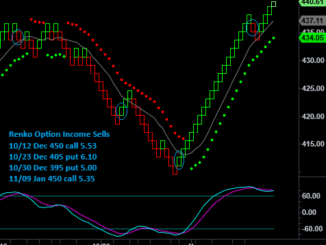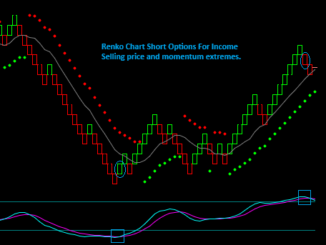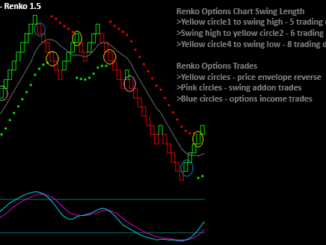What are Renko options strategies?
Our Renko options strategies are tactics used for underlying trading, such as SPY position trading. Our base method for trading Renko charts is used to trade option strategies in multiple ways. We can trade options to replace the underlying [SPY] for directional price movement. And we can also do Renko option trading to generate income.
These 2 Renko options strategies are combined into one trading method, depending on whether the SPY is beginning a new price swing or is at a price and momentum extreme. Again, this is how we use our Renko method for trading at different points on a chart.
We will use the following Renko options trades to emulate trading the SPY:
- Long options trades, buying SPY puts or calls.
- Synthetic options trades, selling calls-buying puts for SPY shorts, and selling puts-buying calls for SPY longs.
We will also sell SPY options for income, using strategies for selling calls against profitable long calls or selling puts against profitable long puts. The option sells can become income by holding them after the option buys are exited.
And you can use Renko options trading strategies for hedging profitable position trades to hold them longer.
Renko Options Position Trading
The directional trading strategies will use the same indicators and setups as our Renko day trading method. But as you can see from the Renko options strategies listed above, we will use different strategies for trading the SPY than for futures trading.
The biggest difference is that you will not trade the SPY underlying [like trading the futures contracts] for these strategies. Instead, we will trade options to replace SPY trading.
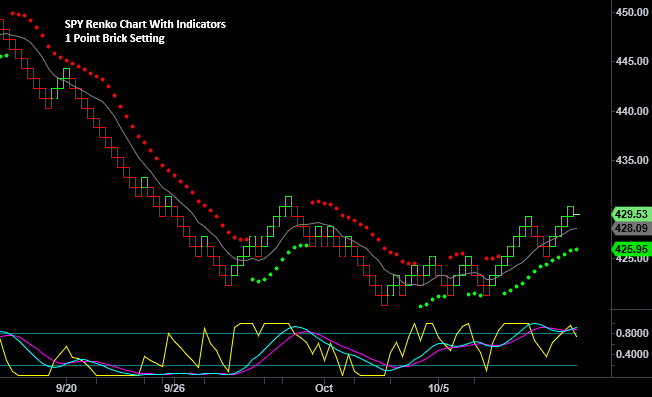
Renko Trading: Charts, Indicators, and Strategies
Another difference is that you hold the trades overnight. These are longer-term trades, which is characteristic of position trading.
And we will also use our trade setups and strategies in two different ways:
- Trade the underlying using our Renko trade setups like the price envelope reverse and midline reject. These are our trade setups for directional trading and the start of a new trading swing. Along with setups for trading price and momentum continuation as add-on trades.
- Trade options at price and momentum extremes against the underlying position. For instance, if we are long the SPY, we will sell a call for some protection along with income. A long underlying and short call is a basic covered call options position.
Replacing The SPY Underlying Trade
The approach combines our strategies into a Renko options position trading method. We are directionally trading from the inside to the outside and selling options from the outside to the inside. Trade the options underlying replacement where a new swing and directional price movement begins. And then trade the options where we anticipate the price swing to reverse from an extreme.
Again, and I will discuss this in greater length, you will trade options to replace the underlying. Trading options in this way is an important Renko options position trading component.
But why not trade the SPY; wouldn’t that be simpler?
Consider the SPY. If you trade in hundred share lots to trade options around your underlying position, you could have 400 shares open at one time.
Let’s consider a trading size where you will take an initial trade of 200 shares to take a partial profit on 100 shares and then trail 100 shares for a bigger move. And then, if you get an add-on trade set up, you would add another 200 more shares.
With the SPY at 425, if all 400 shares were open, this would be $170,000 or $85,000 using a 50% margin. And then you would need approval and margin for SPY short trades.
Trading in an equity account is more expensive than trading on margin in a futures account.
Short Option Trading Approval And Margin
On the other hand, if you made the same trades using options, your capital outlay would be very small.
Consider a synthetic options trade to replace an underlying trade, where you sell one call and buy one put to go short. The cost of the put would be similar to the premium you received for selling the call. The difference between these would be your cost.
Your potential issue with these Renko options strategies and using options for the underlying could be approval to short naked call options. Your account size also must be big enough to cover the margin.
If this is the case, you could make a Renko options position trade buying options instead of using a synthetic trade that could include shorting a call.
Renko Options and Position Trading Decisions
Let’s examine some decisions and tradeoffs you must make for Renko options and position trading. Among these include:
- What size is the Renko chart to use for position trading?
- What session times will you use for your Renko options trading chart?
- Will you trade the underlying or trade the options as a replacement for the underlying?
- If trading the underlying, is your account size big enough for the trading strategies?
- If trading the options for the underlying, are you allowed to sell naked options?
Renko SPY Chart Settings
Two necessary decisions are the brick size for your Renko options strategies chart and the underlying trading sessions to use.
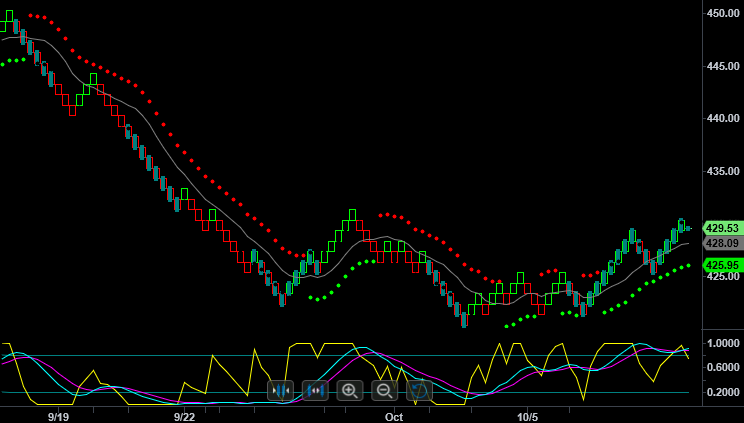
What Is A Renko Chart And Making Renko Chart Bricks
You are looking at a Renko chart of the SPY. I have used this chart for Renko options strategies trading and SPY position trading. I am using a brick setting size of one point.
Why a Renko chart brick setting of one point?
Looking at the paint bars on the chart, you will see 5 sections marked. Four of these sections are 6 to 7 bricks, with the 5th section a wide range reversal day that is an outlier. In comparison, a 60-minute bar chart would have 7 bars.
I’m essentially trying to emulate a 60-minute chart with my brick setting.
Note that this is a TradeStation chart. Why have I used the TradeStation chart instead of the NinjaTrader chart? I have my data for equities with TradeStation; it has nothing to do with NinjaTrader.
So, by all means, use the NinjaTrader chart for your SPY Renko options position trading. But go to the instrument panel and check that your settings for US equities are realtime hours.
What Renko Chart Trading Session To Use
The other Renko position chart setting decision for the SPY will be for the session times used for the underlying.
For instance, you know that when trading the British pound using our Renko day trading method, we use a bricks setting of 3 ticks. The chart session is for the entire time the British pound is open.
You also know from Renko day trading that you get numerous trade setups throughout the day.
In that case, it doesn’t matter what the chart session settings are for day trading. When you start trading, you’ll wait for a trade setup. The last trade setup may have occurred right before you started trading. But it doesn’t matter since there would typically be a new setup in a relatively short time.
On the other hand, Renko options strategies trading and position trading can differ greatly.
Look at the swing with the big selloff. That swing started on September 15, and you got a new swing and a new trade setup on September 27.
You can see how session hours make a big difference. You won’t have frequent new trade setups like you would for day trading.
There is a big decision; what session times will you use?
The session times on the Renko position trading chart for the SPY are the realtime sessions of 8:30 a.m. to 3:00 p.m. central time. I am not using the extended hours like in the case of the British pound, where we use all of the hours the British pound is open.
There is also a 60-minute bar chart included with both the realtime and extended hours in my Renko chart workspace. Trade setups are not taken from this chart.
Why Do the Renko Chart Sessions Matter
The trading sessions matter because I do not want trade setups occurring overnight. There are extended trading sessions before and after the day session. These include the hours of 3 a.m. to the open and then from the close to 7 p.m.
Also, be sure you understand the different hours the SPY is open and the SPY options are open.
Having trade setups during these times will be a problem since, most likely, you and I would not be trading. And especially if you are only Renko trading options, since they would not be open to trade.
This decision is a tradeoff we have to make. Do you want to miss some Renko bricks even if you’re not trading? Do you get every Renko brick on your chart where your indicators can give you trade setups, or will you only show what occurs during the day session?
I have decided to use the Renko chart day session bricks only.
SPY Options Trading Hours
Now, what are the further implications?
You need to study your chart and decide if there are places where you would want to place a resting order for a profit or a stop loss when you are not trading. You would do that knowing that you may have a situation where your stop loss is a trade reverse, and you will miss trading that reverse.
Taking method profits or losses is a case where trade management is more important than potentially missing a new trade.
Remember that these tradeoffs and decisions are not Renko options strategies trading decisions but position trading decisions.
Also, this is only relevant if you are trading the SPY. If you only use options for your SPY Renko position trading, you will be trading them during the realtime hours.
And you can trade SPY options from 9:15 a.m. ET to 4:15 p.m. ET. You have 15-minute buffers at the start and close.
Using Options To Trade The Underlying
Renko position trading using options to trade the underlying has many benefits but also some tradeoffs.
Options are more involved than trading the underlying. You trade multiple options to emulate an underlying position, entailing managing multiple positions instead of one underlying.
But as you become more knowledgeable about options, you will find that they are very flexible for trading.
Questions for Renko options strategies trading:
- What option strikes?
- What quantity of options equals the underlying?
- What option type, puts, or calls?
- Will you trade long options only, or will you trade long-short synthetic positions?
If you trade the SPY, you know it will increase or decrease the same amount as the net change. That is because the SPY, like all underlyings, has a Delta of 100. Delta is the amount of price movement for a one-point change in the underlying.
If you buy 100 SPY shares, its price goes up one point. On the other hand, options do not have a Delta of 100.
For instance, if the SPY 425 and you buy a 425 strike call, your Delta for that call is 50, and you will have to know to buy two calls to get a Delta of 100 like the underlying.
Renko Options Synthetic Trade
On the other hand, you can use options to make synthetic long underlying positions. If you buy one 425 strike call and sell one 425 strike put, you will create a synthetic long SPY.
And what is beneficial about the synthetic position is the long, and the short option combination will have very little cost. If you can sell 1 option and buy 1 option at the same price, there will be no cost.
The long options positions will cost more, but far less than the underlying.
Compare the profit curvature of buying the SPY with the Renko options trade replacement strategy.

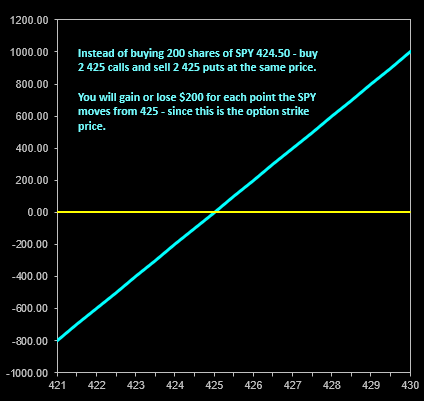
The top graph shows you will gain $200 for each point the SPY moves up or down from 424.50. The bottom graph shows that you will have the same gain per point of movement if the call buy and put sell were the same price.
The difference between the 2 trades is that the synthetic trade profit moves up or down from 425 instead of 424.50. The reason for this is that is the strike price of the options.
Renko Options Position Trade
Let’s look at a Renko options position trade, where the underlying trade is a synthetic long. We are looking at yellow circle2, a buy addon to the initial buy at yellow circle1.

At the time of the trade, you could buy 200 shares at 424.50 = $84,900. Or you could do the trade by buying 4 October 425 calls [buy 4 50 delta calls to match the 200 delta] at 5.20 = $2,080.
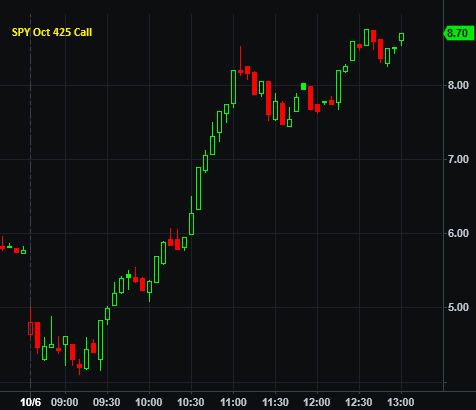
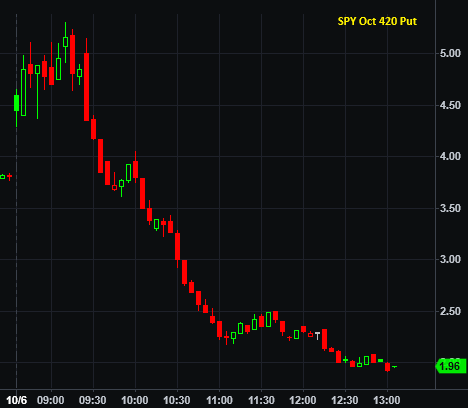
The trade was done as a synthetic options trade. The synthetic long trade was to buy 2 October 425 calls at 5.20 and to sell 2 October 420 puts at 3.90 = $1,040 – $780, or a debit of $260.
$84,900 vs. $2,080 vs. $260 are the relative costs to control the same 200 deltas of buying 200 SPY shares.
Now, look at the Renko options trade math at SPY 429.95.
- SPY: 429.95 – 424.50 * 200 = $1,090
- SPY Oct 425c: 8.70 – 5.20 * 2 = $700
- SPY Oct 420p: 3.90 – 1.96 * 2 = $388
The underlying gain is $1,090, whereas the synthetic long gain is $1,088. The gains are virtually the same, but there is no comparison when comparing what the trades cost.
I also want to compare these 2 trades to the long Renko options trade. The long options would be important to the trader not approved to sell short uncovered call options.
- SPY Oct 425c: 8.70 – 5.20 * 4 = $1,400
The long Renko options trade is the most profitable of the 3.
Why?
If you did this trade, the Delta for the 425 calls was right at 50. But the upside move was so big that the Delta increased to 67. The Delta of the Renko options position went from 200 to 268; you were effectively long 268 shares of the SPY instead of 200.
Further Evaluation Of The Renko Options Position Trade
The Renko options strategies position trade needs further evaluation because the comparison isn’t quite apples to apples. Since the synthetic trade was buying a 425 call and selling a 420 put, the trade was less than 200 delta long.
I did this because I wanted to sell a put out of the money instead of the at the money 425 put when the SPY was 424.50 after a very negative open.
I will discuss the strategy further in another post, but there would be a Renko options trade where the long calls are closed for profit, but the short puts will remain open for further income.
Regarding the trade comparison, since the long Delta of the Renko synthetic options trade was less than 200, the profit should be lower than buying the 4 long 425 calls.
The synthetic long would also not have the same delta gain as the long calls.
The long Renko options trade delta increase is a benefit compared to the long SPY; the underlying trade delta would remain constant.
Renko Options Strategies Trading Video
I will discuss the yellow circle options strategies in this Renko options trading video. And I will talk about the blue circles that were previously traded.
I will especially focus on the Renko options strategies for using parts of an existing trade when another trade is done. In this case, what if there was already an open short put from the blue circle trade at the time of the yellow circle2 call buy-put short synthetic options trade?
Renko Options Strategies Trading Video
The video will give you more insights into our Renko options strategies and using options for SPY position trading.


